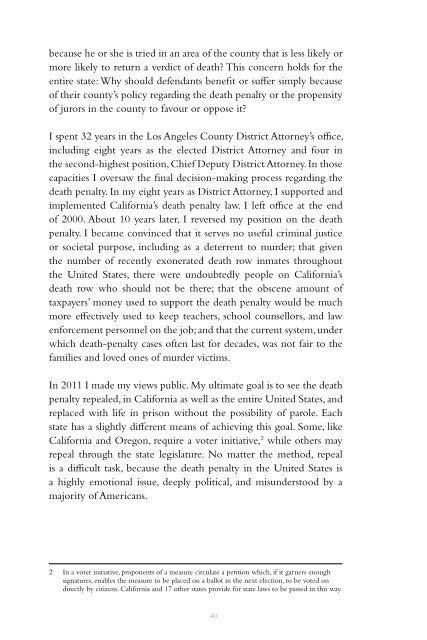PENALTY
DBk0302s7Xm
DBk0302s7Xm
Create successful ePaper yourself
Turn your PDF publications into a flip-book with our unique Google optimized e-Paper software.
ecause he or she is tried in an area of the county that is less likely or<br />
more likely to return a verdict of death? This concern holds for the<br />
entire state: Why should defendants benefit or suffer simply because<br />
of their county’s policy regarding the death penalty or the propensity<br />
of jurors in the county to favour or oppose it?<br />
I spent 32 years in the Los Angeles County District Attorney’s office,<br />
including eight years as the elected District Attorney and four in<br />
the second-highest position, Chief Deputy District Attorney. In those<br />
capacities I oversaw the final decision-making process regarding the<br />
death penalty. In my eight years as District Attorney, I supported and<br />
implemented California’s death penalty law. I left office at the end<br />
of 2000. About 10 years later, I reversed my position on the death<br />
penalty. I became convinced that it serves no useful criminal justice<br />
or societal purpose, including as a deterrent to murder; that given<br />
the number of recently exonerated death row inmates throughout<br />
the United States, there were undoubtedly people on California’s<br />
death row who should not be there; that the obscene amount of<br />
taxpayers’ money used to support the death penalty would be much<br />
more effectively used to keep teachers, school counsellors, and law<br />
enforcement personnel on the job; and that the current system, under<br />
which death-penalty cases often last for decades, was not fair to the<br />
families and loved ones of murder victims.<br />
In 2011 I made my views public. My ultimate goal is to see the death<br />
penalty repealed, in California as well as the entire United States, and<br />
replaced with life in prison without the possibility of parole. Each<br />
state has a slightly different means of achieving this goal. Some, like<br />
California and Oregon, require a voter initiative, 2 while others may<br />
repeal through the state legislature. No matter the method, repeal<br />
is a difficult task, because the death penalty in the United States is<br />
a highly emotional issue, deeply political, and misunderstood by a<br />
majority of Americans.<br />
2 In a voter initiative, proponents of a measure circulate a petition which, if it garners enough<br />
signatures, enables the measure to be placed on a ballot in the next election, to be voted on<br />
directly by citizens. California and 17 other states provide for state laws to be passed in this way.<br />
THE CALIFORNIA MORATORIUM<br />
The hard facts behind the death penalty process have begun to come<br />
to light in the United States, giving some of our political leaders,<br />
including vocal supporters of the death penalty, a reason to pause<br />
and think critically about the system. Many have publicly supported<br />
a moratorium in order to allow time for a meaningful conversation<br />
on the issue. California has since 2006 had a de facto moratorium<br />
on executions due to ongoing legal challenges to the state’s lethal<br />
injection protocol. This has created an environment that has allowed<br />
us to move closer to achieving our goal of replacing the death penalty<br />
with life in prison without the possibility of parole.<br />
California’s de facto moratorium, as well as the moratoriums imposed<br />
by the governors of the states of Oregon, Washington and Colorado,<br />
have undoubtedly created an environment in which full repeal is<br />
more plausible. The positive effect of moratoriums can be seen most<br />
clearly in New Jersey, where a moratorium on executions was put in<br />
place in 2004 due to the lack of a proper lethal injection procedure.<br />
In the following years, questions about the effectiveness of the death<br />
penalty as a deterrent, cost feasibility, and, critically, the risk of sentencing<br />
innocents to death led New Jersey to repeal its death penalty<br />
in 2007. The de facto moratorium in California has similarly created<br />
an environment of scrutiny.<br />
To fully understand the de facto moratorium in California, it is helpful<br />
to go back a few decades. After several years without a death<br />
penalty, California voters reinstated it in 1978 in an initiative process.<br />
Not many years after reinstatement, both supporters and opponents<br />
of the death penalty became very unhappy with the how it was<br />
being administered. In 2004, the California State Senate established<br />
the California Commission on the Fair Administration of Justice,<br />
a bipartisan blue-ribbon panel tasked with speeding up the death<br />
penalty process, investigating the causes of wrongful convictions and<br />
executions in the state, and recommending reforms. The resulting<br />
report made substantive recommendations for change. Even though<br />
highly respected individuals on both sides of the argument urged<br />
the legislature to adopt major changes in the administration of the<br />
death penalty, no meaningful change was adopted by the legislature.<br />
40 41


